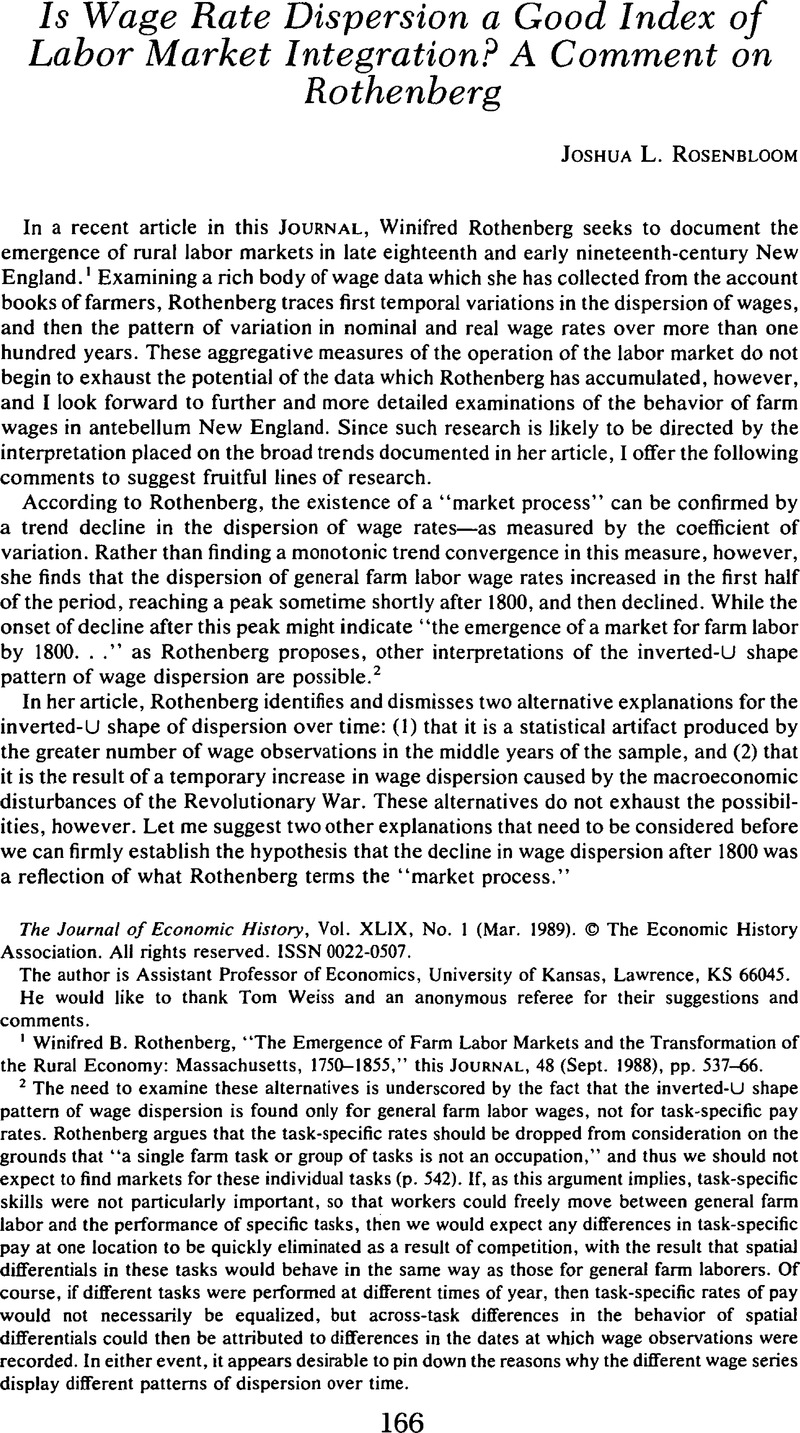Published online by Cambridge University Press: 03 March 2009

He would like to thank Tom Weiss and an anonymous referee for their suggestions and comments.
1 Rothenberg, Winifred B., “The Emergence of Farm Labor Markets and the Transformation of the Rural Economy: Massachusetts, 1750–1855”, this JOURNAL, 48 (09. 1988), pp. 537–66.Google Scholar
2 The need to examine these alternatives is underscored by the fact that the inverted-U shape pattern of wage dispersion is found only for general farm labor wages, not for task-specific pay rates. Rothenberg argues that the task-specific rates should be dropped from consideration on the grounds that “a single farm task or group of tasks is not an occupation”, and thus we should not expect to find markets for these individual tasks (p. 542). If, as this argument implies, task-specific skills were not particularly important, so that workers could freely move between general farm labor and the performance of specific tasks, then we would expect any differences in task-specific pay at one location to be quickly eliminated as a result of competition, with the result that spatial differentials in these tasks would behave in the same way as those for general farm laborers. Of course, if different tasks were performed at different times of year, then task-specific rates of pay would not necessarily be equalized, but across-task differences in the behavior of spatial differentials could then be attributed to differences in the dates at which wage observations were recorded. In either event, it appears desirable to pin down the reasons why the different wage series display different patterns of dispersion over time.
3 Fluctuations in geographic dispersion are not unique to the labor market. The large literature on late nineteenth-century capital markets has stressed the integration which occurred over time, and not the variation in dispersion that manifested itself on occasion. The coefficient of variation of regional interest rate data for the period 1870 to 1914 shows peaks and troughs, however, that correspond closely to those illustrated in Figure I. This suggests that some caution should be exercised in distinguishing between the trend reduction and cyclical variations in interest rate dispersion. See Smiley, Gene, “Interest Rate Movements in the United States, 1888–1913”, this JOURNAL, 35 (09. 1975), pp. 591–620.Google Scholar
4 The decline in dispersion between the two peaks appears to be attributable to the convergence of wages in San Francisco toward those in the other cities in the sample, and is not a symptom of any more general wage convergence. See Rosenbloom, Joshua L., “Labor Market Institutions and the Geographic Integration of Labor Markets in the Late Nineteenth-Century United States” (Ph.D. diss., Stanford University, 1988), chap. 3.Google Scholar
5 One might object that it is unreasonable to attribute a single peak in a one hundred year sample to the same forces which induced two peaks in a period of less than thirty years at the end of the nineteenth century. The single peakedness, however, may be just a product of Rothenberg's technique of regressing the coefficient of variation on a polynomial time trend in order to find a single turning point in the data. The low values of R2 reported for these regressions suggest, however, that there is a good deal of temporal variation in the coefficient of variation which is not explained by the simple inverted-U shape of the fitted equation. Thus, the peak around 1800 may simply reflect a somewhat larger than normal set of disturbances. To resolve this question it is necessary to look more closely at the underlying data.
6 Mirowski, Philip, “What Do Markets Do? Efficiency Tests of the 18th-Century London Stock Market”, Explorations in Economic History, 24 (04. 1987), pp. 107–29, makes this point in the context of the performance of the eighteenth century London stock market. According to Mirowski, the persistent and systematic deviation of share prices from the levels predicted by efficient market models can be understood as a result of the other roles which stock ownership played—especially in giving share holders a vote on their company's actions.CrossRefGoogle Scholar
7 Rothenberg, Winifred B., “The Emergence of Farm Labor Markets”, pp. 554–55.Google Scholar Even today, when markets seem to be well established, the widening of interregional differentials in per capita income during the last decade indicates that objectives besides the maximization of current income continue to play an important role in labor market decisions. See Clark, Lindley H. Jr, “Prosperity Increasingly Tied in Part to Map”, Wall Street Journal, 6 10 1988, p. A2.Google Scholar